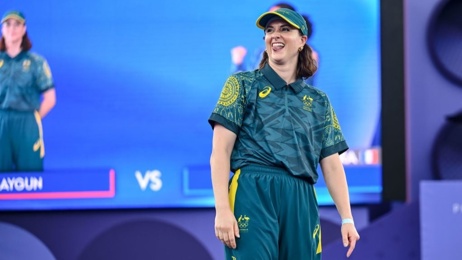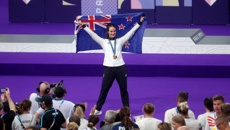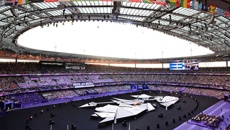By Michael Burgess in Paris
Canoe Racing New Zealand are defending the decision to have a C2 500m crew at the Paris Olympics, after the boat finished almost a minute adrift of the rest of the field in their races on Tuesday.
In scenes that reminded of ‘Eric the Eel’ at the Sydney Olympics, or ‘Eddie the Eagle’ at the Winter Games of 1988, the Kiwi combination of Max Brown and Grant Clancy – who have only been learning the discipline for three months – trailed the field by more than 50m at the finish. and were still on the course when other crews were heading back to the jetty.
While their efforts attracted generous, sympathetic applause in the grandstands, it also raised some eyebrows with fans and media alike at the venue. It’s an unusual situation. It came about earlier this year when CRNZ decided to take advantage of a quirk in the qualification rules. They entered a C2 500m boat at the Oceania championships in Feburary, with the winner of the three nation race (against Samoa and Australia) gaining an automatic spot to Paris.
 The New Zealand men's C2 team were not even in the picture at the finish. Photo / Sky Sport
The New Zealand men's C2 team were not even in the picture at the finish. Photo / Sky Sport
That success gained two more Olympic quota spots – which enabled them to send a K4 crew to the Olympics, as Brown and Kurtis Imrie had already qualified a K2 boat. The priority target was the big boat but they had missed a spot through other more conventional routes, which resulted in Tuesday’s scenario, with a pair of rookies in the C2 500m race against the best nations in the sport.
CRNZ high performance boss Nathan Luce agrees it was an unorthodox move but feels the end justifies the means, given the encouraging performance in the K4 500m on Tuesday, where the New Zealand crew progressed to the semifinals on Thursday, via a second place in their quarter-final.
 Max Brown and Grant Clancy in the mens canoe double 500m canoe sprint at Vaires-sur-Marne Nautical Stadium-flat water. Photo / Iain McGregor / www.photosport.nz
Max Brown and Grant Clancy in the mens canoe double 500m canoe sprint at Vaires-sur-Marne Nautical Stadium-flat water. Photo / Iain McGregor / www.photosport.nz
“The results showed that they deserve to be here,” Luce told the Herald. “They had the sixth best time across the 11 boats leading into the semis and that’s what you want in the Olympic Games, you want your best boats competing. Sure, we found a roundabout way to get them here but they’re here and they’ve proved they belong.”
Despite some likely adverse reaction, Luce also had no issue with the spectacle created in the C2 500m, with the New Zealand boat nowhere near their rivals.
“I don’t think they disrespected the C2 discipline,” said Luce. “There are developing countries that come to the Games all the time. It’s not just about winning and medals….there are athletes across all disciplines.”
 New Zealand Mens Kayak Four - Max Brown, Grant Clancy, Kurtis Imrie and Hamish Legarth in their quarter final. Photo / Photosport
New Zealand Mens Kayak Four - Max Brown, Grant Clancy, Kurtis Imrie and Hamish Legarth in their quarter final. Photo / Photosport
Luce felt that Clancy and Brown, who faced a steep learning curve, had acquitted themselves well. In the heat they crossed the line in 2.22.09, more than 40 seconds behind the next slowest boat. In their quarter-final they recorded 2:24.09, 35 seconds behind the 4th placed Angolan crew.
“I’m really proud of the guys,” said Luce. “They learned how to steer with the paddles, to keep the boat straight and they did that in some big wash. They didn’t get disqualified and they’ve gone through successive rounds. They’ve showed that, okay, this is the starting point for the discipline in New Zealand. And who knows, maybe there’s some kids back home who want to give it a go?
Brown and Clancy had found it a positive experience. With plenty of nerves about what might happen on the big stage, they were relieved they had completed the course twice, without any mishaps.
“The main challenge we found going from kayak to canoe is that there’s no rudder,” explained Clancy. “So the hardest part is actually steering. It is all done with the paddle. And you don’t have those skills in kayak because you just use the rudder to steer. So that was our biggest challenge - staying in the lane.”
New Zealand lost ground after just a few strokes – as they were understandably tentative from the start – and soon saw their opposition disappear into the distance.
“The competitor in me wants to be competing there,” said Brown. “But for us, we used Kiwi ingenuity to qualify this K4 four that we were so close to in world champs and I always brought it back to that.”
Brown and Clancy have gained a lot more respect for the unusual sport, after the painful – mental and physical process – of learning the craft. The athletes also brushed off the inevitable negative reaction that will follow in the coming days.
“No rules have been broken,” said Brown. “We’ve followed the process the whole time and it’s been justified by our [K4] results today. It won’t be the first time in sport that, you know, things have been different to how they usually pan out. And some of the coolest stories - I think back to the Jamaican bobsleigh and all those things, they’re unreal.
“It was actually cool when we were paddling our last 200m by ourselves, you could hear the crowd supporting us. You don’t know how you’re going to be received [but] the world keeps turning and we’re just stoked to be here and others seem to be happy as well.”
Aside from the C2 500m, which became an unexpected talking point, the key crews looked good on Tuesday.
The women’s K4 were impressive in winning their heat, to progress directly to Thursday’s semifinal before Carrington and Hoskin followed up with a strong performance in the K2 500m for direct passage to their semifinals, scheduled for Friday.
The other women’s K2 500m pairing of Aimee Fisher and Lucy Matehaere missed the cut, after a fifth-placed finish in the quarter-finals. Kurtis Imrie and Hamish Legarth squeezed into the semifinals of the men’s K2 500, via a photo finish in their quarter-final.
 Lisa Carrington successfully led her women's K4 kayak sprint team into the event's final at the Paris Olympics. Photo / Photosport
Lisa Carrington successfully led her women's K4 kayak sprint team into the event's final at the Paris Olympics. Photo / Photosport
Take your Radio, Podcasts and Music with you









